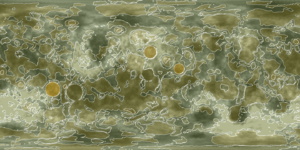Tylo
Tylo is the third moon of Jool. It is the largest of Jool's five moons, the largest moon in the entire Kerbol System, and the largest celestial body without an atmosphere. It is Kerbal Space Program's analog for Ganymede, a moon of Jupiter.
Landing on Tylo is extremely challenging. Its gravity is similar to Kerbin's, but aerobraking is impossible, since there is no atmosphere. However, due to its large gravity well, Tylo is an ideal target for a gravity assist to enter or leave the Jool system safely and with minimal fuel consumption.
Having a spacecraft orbiting very close to the surface can give you orbit periods of about 29 minutes going about 2,170 m/s. Like the other large Joolian moons, Tylo is tidally locked. Synchronous orbits around Tylo are not possible, as they would lie outside of its SOI, at a radius of 14,758,067 meters.
According to former developer NovaSilisko, Tylo was planned to possibly be made into a high-contrasting body like Iapetus.[1]
Contents
In-game Description
| “ | Tylo was the first moon of Jool to be discovered by the Kerbal Astronomical Society. After many failed attempts to take a flawless picture of Jool to hang on the office walls, it was finally discovered that the wandering white smear was indeed a moon. Scientists speculate that the view from the surface with Laythe, Vall, and Jool overhead must be quite something. — Kerbal Astronomical Society. |
” |
Topography
Tylo has a rocky surface. It has a varying elevation between 0 meters (Tylo baseline height) and peaks of more than 11290 meters. Tylo's surface looks similar to that of Mün, but has much fewer impact craters (especially on the side facing away from Jool) and is more uneven.
Due to the coloring of the surface of Tylo, it is likely that it is covered in a rhyolite layer of rock, nickel, a little cobalt, some sort of ice and dust, spread by meteorite impacts, but as there is no official way to determine the composition of the moon this is only hypothetical. This explains why Tylo has a rather bright and white surface.
Because it is very large in comparison to other moons, it is unlikely that it is a captured planet. For a planet of this size, Jool would have to be much larger and denser to produce a large and strong enough gravitational well. It is unknown why Tylo hasn't formed an atmosphere.
Because of its high gravity and lack of an atmosphere, Tylo is very hard to land on and reach orbit from. However, low altitude orbits at high speeds can be achieved for these same reasons.
Biomes
Tylo has 8 Biomes. Three biomes have the exact same name but are seen separately in KSP. It is unknown, if this is a bug or was simply overlooked by Squad.
Biome list
- Highlands
- Midlands
- Lowlands
- Mara
- Minor Craters
- Major Crater
- Major Crater
- Major Crater
Science
Tylo has the second-highest science multipliers in the game. The only orbit with a higher multiplier is the sun and the only surface with a better multiplier is that of Eve. Unfortunately Tylo has no atmosphere, which means that there is one less zone to conduct experiments in and that some experiments do not work at all. That means that it is only the second most science-rich Joolean moon after Laythe.
Reference Frames
| Time warp | Minimum Altitude |
|---|---|
| 1× | Any |
| 5× | 30 000 m |
| 10× | 30 000 m |
| 50× | 60 000 m |
| 100× | 120 000 m |
| 1 000× | 240 000 m |
| 10 000× | 480 000 m |
| 100 000× | 600 000 m |
Trivia
- Kerbin has the same equatorial radius as Tylo (600,000m) yet Tylo's surface gravity is much lower than Kerbin. This is most likely because Tylo is composed of low density matter.
- There are two known Easter eggs on Tylo.
Gallery
Notes
- ↑ Post in the forum by NovaSilisko
Changes
- Added biomes
- Initial release






